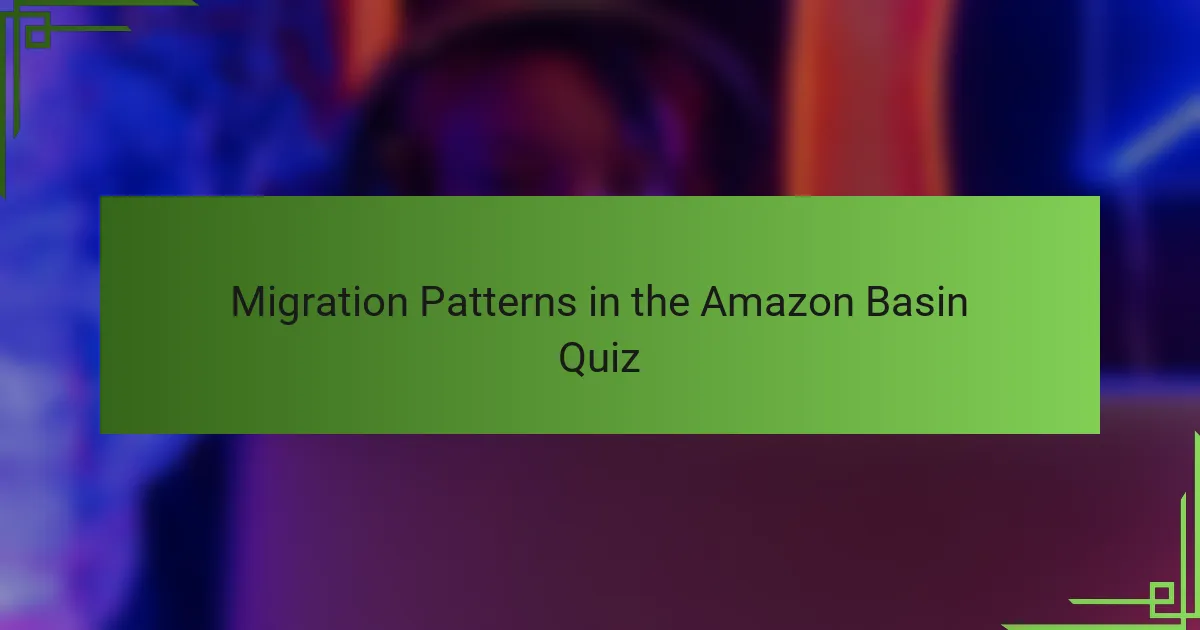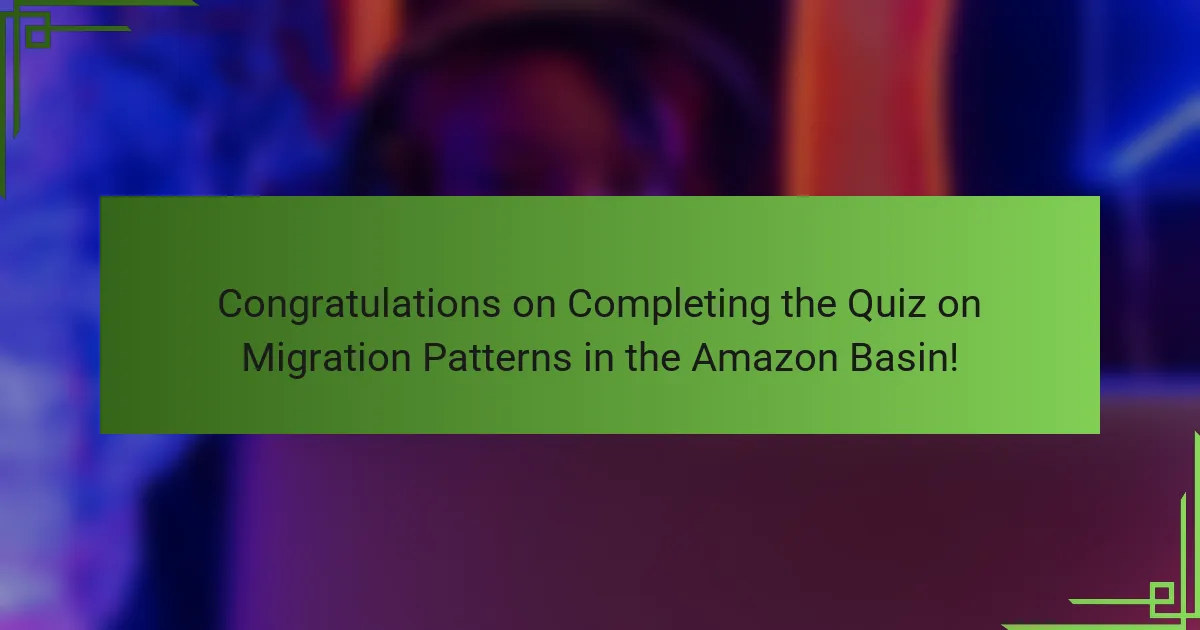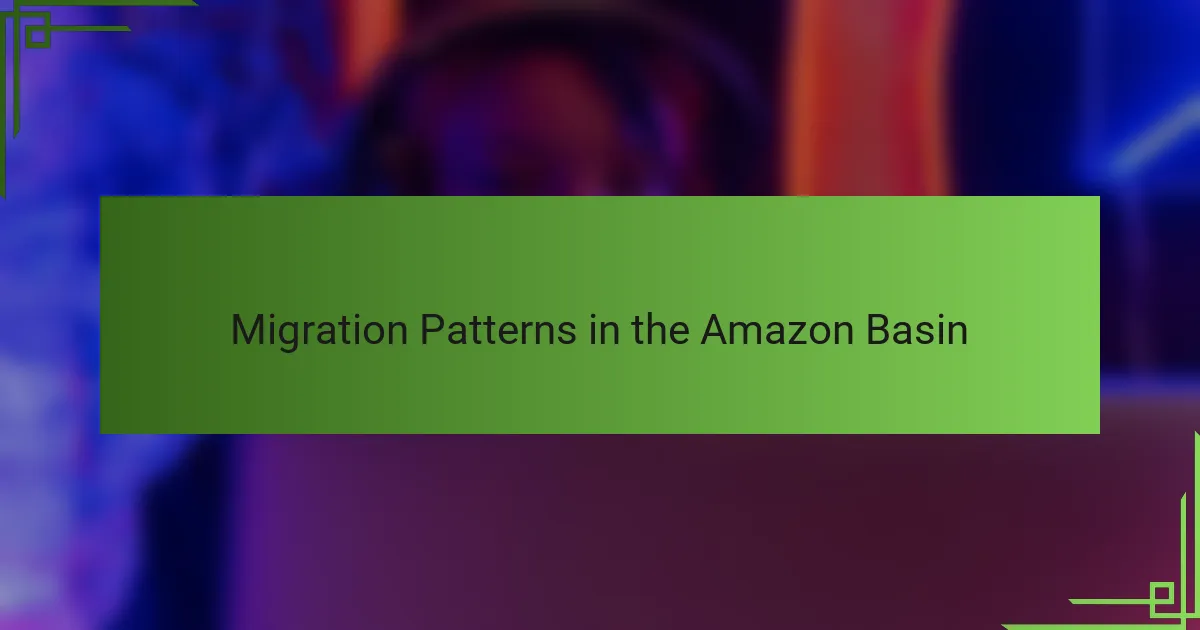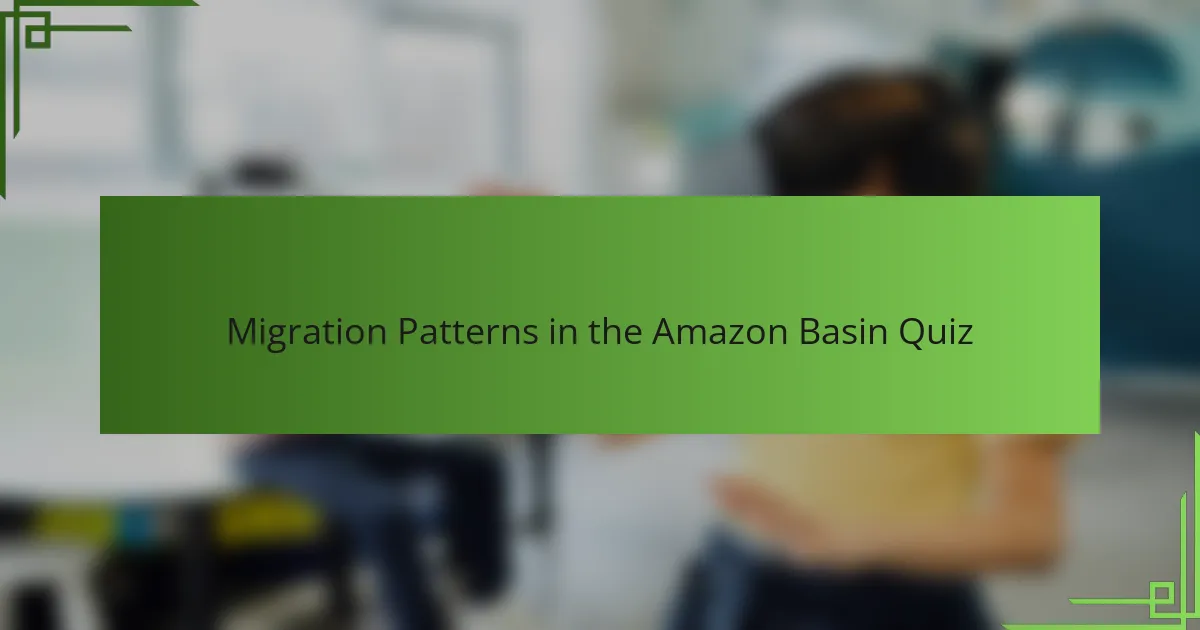
Migration Patterns in the Amazon Basin Quiz
1. What is the primary reason for seasonal migration among indigenous communities in the Amazon Basin?
- To reach trading hubs that are only accessible seasonally
- To access seasonal food sources linked to flooding cycles
- To find higher ground during the dry season for better shelter
- To move away from areas of increased predatory animal activity
2. Which river in the Amazon Basin is most associated with fish migration patterns during the wet season?
- Rio Negro
- Rio Tapajós
- Rio Madeira
- Rio Xingu
3. How do the migratory patterns of the Amazon River dolphin influence local fishing practices?
- Fishermen follow the dolphin migrations because the dolphins directly guide them to large schools of fish.
- The dolphins’ migration results in fishermen relocating their villages along riverbanks to stay closer to fishing hotspots.
- The dolphin`s migration causes fishermen to restrict fishing during the dry season to protect the species.
- The Amazon River dolphin migrates seasonally to flooded forests, leading fishermen to adjust their fishing locations and methods to avoid competition and maximize catch.
4. What role do the floodplains along the Rio Negro play in the migration of aquatic species?
- They act primarily as barriers that limit the movement of aquatic species, forcing isolated populations to adapt independently.
- They are desiccated zones during the dry season that concentrate aquatic species into small pools, reducing migration opportunities.
- They provide seasonal breeding and nursery habitats that facilitate the reproduction and growth of aquatic species.
- They serve as permanent migration corridors that fish use year-round to travel between the ocean and inland waters.
5. Which migratory bird species is commonly observed traveling through the Amazon rainforest during the dry season?
- Blue-winged Parrotlet
- Scarlet Macaw
- Harpy Eagle
- Swallow-tailed Kite
6. How does the migration of giant otters affect the biodiversity of the Amazon Basin?
- Migration causes a decline in predator species, which reduces biodiversity in the Amazon Basin.
- Giant otter movements introduce new aquatic plant species, altering wetland ecosystems.
- Giant otter migration helps maintain fish population balance, promoting overall aquatic biodiversity in the Amazon Basin.
- Their migration disperses tree seeds, directly boosting plant diversity across the Amazon.
7. What impact does the migration of the arapaima fish have on indigenous fishing communities in the Amazon?
- Migration of arapaima fish increases the genetic diversity of fish stocks, improving long-term sustainability of fisheries.
- Migration of arapaima fish results in increased competition with invasive fish species, reducing overall fish populations.
- Migration of arapaima fish causes permanent relocation of indigenous communities due to habitat loss.
- Migration of arapaima fish leads to seasonal fluctuations in fish availability, affecting indigenous communities` fishing schedules and food security.
8. Which indigenous group in the Amazon Basin is known for following seasonal migration patterns related to cassava cultivation?
- The Yanomami
- The Matsés
- The Kayapo
- The Tukano
9. How do migratory patterns of the pink river dolphin differ between the Amazon and its tributaries?
- Dolphins in tributaries undertake longer migrations than those in the main Amazon Channel, moving to different river basins annually.
- Dolphins in the Amazon tributaries migrate yearly to the ocean, but remain resident in the main Amazon River.
- Pink river dolphins migrate upstream in the Amazon during the dry season but remain stationary in tributaries.
- Pink river dolphins in the Amazon migrate seasonally following water levels, while in tributaries they show more localized movement based on food availability.
10. What geographic features influence the migration routes of freshwater turtles in the Amazon Basin?
- River currents and seasonal floodplains
- Coastal tides and coral reefs
- Mountain ranges and forest density
- Desert boundaries and sand dunes
11. Which Amazon Basin national park is noted for studies on animal migration corridors?
- Serra do Divisor National Park
- Tumucumaque Mountains National Park
- Mamirauá Sustainable Development Reserve
- Jaú National Park
12. How does the migratory behavior of the hoatzin bird reflect changes in the Amazon Basin`s wetland ecosystems?
- Hoatzin migration correlates with competition for nesting sites with other bird species rather than wetland ecosystem changes.
- Seasonal temperature variations in the Amazon force the hoatzin to migrate for better nesting conditions in higher elevation areas.
- The hoatzin`s migratory patterns have shifted due to altered flooding regimes in Amazon wetlands, reflecting habitat changes affecting food availability.
- The hoatzin migrates to avoid predation pressures that have increased with deforestation in the Amazon Basin.
13. What is the significance of the Amazon River`s flood pulse in shaping fish migration patterns?
- The flood pulse reduces oxygen levels, which drives fish to migrate toward areas with higher elevation.
- The flood pulse creates seasonal aquatic habitats that trigger fish migration for spawning and feeding in the Amazon River basin.
- The flood pulse deposits sediment that blocks fish migration routes, causing fish to migrate around the basin.
- The flood pulse causes permanent displacement of fish species, forcing them to migrate upstream indefinitely.
14. Which major Amazon tributary is central to the migration of migratory waterfowl species?
- Tapajós River
- Xingu River
- Madeira River
- Negro River
15. How do human settlements along the Madeira River affect natural migration pathways in the Amazon Basin?
- Settlements along the Madeira River disrupt natural fish migration routes by blocking tributaries and increasing sedimentation.
- Settlements improve natural migration by reducing predator populations along the river corridors.
- Settlements enhance natural migration by creating new aquatic pathways and reservoirs along the river.
- Human settlements have no impact on migration since fish exclusively migrate through main river channels unaffected by tributaries.

Congratulations on Completing the Quiz on Migration Patterns in the Amazon Basin!
We hope you found this quiz both engaging and informative. Exploring migration patterns in the Amazon Basin offers valuable insight into how geography shapes human and animal movement in one of the most dynamic ecosystems on Earth. The questions aimed to deepen your understanding of the factors influencing migrations, such as climate, seasonal changes, and habitat availability.
Throughout the quiz, you likely enhanced your knowledge about the diverse species that migrate and how indigenous communities adapt to these natural rhythms. These patterns are crucial not only for ecological balance but also for the cultural and economic wellbeing of the region. Understanding such complex interactions is key to appreciating the importance of preserving the Amazon Basin’s unique geography.
To continue expanding your grasp of this fascinating subject, we invite you to explore the next section on this page. It offers detailed information on migration patterns in the Amazon Basin, including maps, case studies, and recent research findings. Delve deeper to connect the quiz concepts with real-world geography and broaden your perspective even further.

Migration Patterns in the Amazon Basin
Overview of Migration Patterns in the Amazon Basin
The Amazon Basin, spanning several South American countries including Brazil, Peru, and Colombia, exhibits diverse migration patterns influenced by geographic and environmental factors. Migration here involves movement of indigenous peoples, rural settlers, and urban populations. Environmental conditions such as river systems and rainforest density significantly impact these migration routes. The wide network of the Amazon River and its tributaries acts as primary corridors facilitating movement across this expansive and challenging terrain.
Role of the Amazon River in Shaping Human Migration
The Amazon River, the largest river by discharge volume globally, is central to migration in the Amazon Basin. It provides navigable pathways for travel and transport that overcome dense forest barriers. Communities along the riverbanks, such as those in the Brazilian states of Amazonas and Pará, rely on the river for seasonal migration tied to fishing and agricultural cycles. The river’s flood pulses also dictate temporary relocations, as settlements adjust to changing water levels.
Impact of Indigenous Migration on Geographic Distribution
Indigenous groups such as the Yanomami, Kayapo, and Tikuna have historically migrated within the Amazon Basin to access resources and maintain their traditional lifestyles. These migrations are often small-scale and seasonal, shaped by ecological knowledge. Geographic distribution reflects these patterns, with indigenous settlements concentrated in protected areas and along tributaries. Recent migratory changes have been influenced by external pressures such as deforestation and governmental policies impacting land use.
Effects of Colonization and Economic Activities on Migration
Colonization introduced new migration dynamics, including the movement of settlers and laborers in search of resources like rubber and minerals. In the late 19th and 20th centuries, rubber booms in regions like Acre and Mato Grosso attracted large influxes of workers, reshaping local populations. Economic activities, including logging and agriculture, continue to drive rural-urban migration, especially towards cities like Manaus and Belém. These migrations alter the demographic and geographic landscapes of the basin.
Migration Induced by Environmental Changes in the Amazon Basin
Environmental changes such as deforestation, flooding, and climate variability have increasingly influenced migration in the Amazon Basin. Deforestation, driven by agriculture and infrastructure projects, has displaced indigenous and rural communities, pushing them toward urban centers or into new frontier areas. Flood events along the Amazon and its tributaries force temporary or permanent relocations. Geographic shifts caused by these factors are contributing to changing human settlement patterns within the basin’s complex ecosystem.
What are the main types of migration patterns observed in the Amazon Basin?
The main types of migration patterns in the Amazon Basin include rural-to-urban migration, seasonal migration, and indigenous subsistence migration. Rural-to-urban migration involves people moving from remote forest areas to cities for employment opportunities, primarily driven by economic factors. Seasonal migration occurs when workers move temporarily for agricultural harvests or resource extraction. Indigenous subsistence migration involves small-scale movements within the forest to hunt, fish, and gather. Studies by the Instituto Nacional de Pesquisas da Amazônia (INPA) confirm these patterns, highlighting economic shifts and environmental changes as driving forces.
How does riverine geography influence migration patterns in the Amazon Basin?
Riverine geography strongly shapes migration patterns in the Amazon Basin by serving as natural transportation routes. Many indigenous and non-indigenous communities rely on rivers like the Amazon, Negro, and Madeira for movement and access to resources. Waterways enable seasonal migration and trade, facilitating population mobility in an otherwise dense forest environment. Research by the Brazilian Institute of Geography and Statistics (IBGE) shows that settlements and migration flows cluster around major rivers due to the ease of transport and access to food and markets.
Where do most migrants within the Amazon Basin relocate to?
Most migrants within the Amazon Basin relocate to larger urban centers such as Manaus in Brazil and Iquitos in Peru. These cities provide better employment, education, and healthcare than remote forest areas. According to census data from IBGE and the Peruvian National Institute of Statistics and Informatics (INEI), substantial internal migration flows target these hubs, especially from rural and indigenous communities seeking improved living standards.
When did significant migration waves to the Amazon Basin peak in recent history?
Significant migration waves to the Amazon Basin peaked between the 1960s and 1980s. This period coincided with government policies promoting deforestation, agricultural colonization, and infrastructure projects like the Trans-Amazonian Highway. These activities attracted landless farmers and workers. Historical records from Brazil’s National Institute for Amazonian Research document this migration surge, which profoundly altered demographic and ecological patterns in the region.
Who are the primary groups involved in migration within the Amazon Basin?
The primary groups involved in migration within the Amazon Basin are indigenous peoples, mestizo settlers, and rubber tappers. Indigenous groups often engage in localized migration for subsistence, while mestizo settlers migrate for agriculture, logging, and mining jobs. Rubber tappers historically migrated seasonally in search of latex resources. Sociological studies from the Amazonian Research Institute detail these groups and their distinct migration motives linked to economic opportunities and cultural practices.
